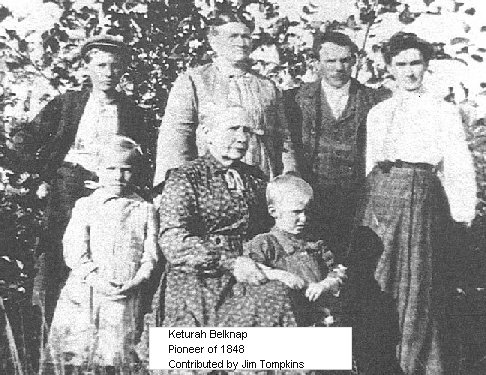Last year I posted several times about travel along the Oregon Trail in 1847, the year in which the novel I am working on takes place. (Click here and here for samples, or search this blog for “Oregon Trail.”)
Several readers have asked what I’m going to do in 2013. My answer: The same thing. About once a month I’ll post here about travel to Oregon in the late 1840s. There is plenty of material about travel along the Oregon Trail to last this blog for many years!
As the pioneers prepared to make their journeys, much of the work fell to women. Here is a description from Keturah Belknap, a housewife who wrote in late 1847 about her family’s preparations to emigrate to Oregon in 1848. Some of their relatives had made the trip in earlier years, and Keturah’s family was about to join them.
Keturah made the clothing for her family, and also other materials needed for the journey, while the men procured the oxen, yokes and wagons. Describing her work, Keturah wrote:
Will make a muslin cover for the wagon as we will have to double cover so we can keep warm and dry; put the muslin on first and then the heavy linen one for strength. They both have to be sewed real good and strong and I have to spin the thread and sew all these long seams with my fingers, then I have to make a new feather tick for my bed. I will put the feathers of two beds into one tick and sleep on it.”
“I think we are fixed very comfortable for the trip. There is quite a train of connection. Father Belknap [Jesse Belknap] has one wagon and 4 yoke of oxen; Hayley [Hawley?] has two wagons and 8 yoke of oxen; Newton about the same; Uncle John Starr has two wagons and 4 yoke of oxen; G.W. Bethards one wagon and 3 yoke of oxen; we have the same besides 3 horses and 10 cows.”
Keturah notes that their family was “fixed very comfortable.” In fact, the Belknap family appears to have been reasonably well off and better prepared for the journey than most of the Oregon pioneers. Many of the emigrants couldn’t afford four yoke of oxen for each wagon, and had to make do with fewer beasts.
Better equipped families could make better time on the trail. Illness, lack of food, and wagon breakdowns also delayed some travelers. (Just like in the game “Oregon Trail” that many of us have played!)
Dissension often arose between emigrants who could travel faster and those who could not. I used this source of tension in my novel – some of my characters can match the Belknaps’ resources, others cannot.
But even though the Belknaps were well-prepared for the trip, they still suffered hardships along the way. One of Keturah’s children was sick for much of the journey. And she was pregnant and bore another child before they reached their destination in Oregon. See Best of Covered Wagon Women, by Kenneth L. Holmes.

Keturah Belknap was born in Ohio in 1820. In 1839, she married and traveled with her new husband to Iowa. They made the journey to Oregon in 1848. Keturah then lived for many years in Oregon, dying in 1913 at the age of 93.
You will probably hear more about Keturah in future posts. She was one of the great women chroniclers of the western migration.




I enjoy your blog Theresa, but then I enjoy history. I think the older I get the more interesting it becomes.Your creative ability to draw your reader takes me into the lives of your characters with precision and stimulates insight and empathy for them.
Thank you, Carole! I appreciate your feedback.
Theresa
Very interesting post, Theresa! You make history much more interesting than my professor in college ever did. 🙂
Thanks, Jill. (I never particularly enjoyed history in school either. For me, it takes seeing the stories behind the facts.)
Theresa
And I thought making tractor covers was difficult!
I’m really glad to hear that someone is making a novel about Keturah. She was my GGGG aunt. My GGG grandma was her husband’s sister, Hannah Gilbert . GGG Grandpa was Lorenzo Dow Gilbert. At a Berreman Family Reunion in 1998 met a distant cousin who gave me a copy of ”On Her Way Rejoicing” Fascinating!
Well, my novel about the Oregon Trail isn’t about Keturah, and she is not a character in it. But portions of her diary are among my research sources. She was an interesting character, and wrote well about everyday life in her times.
Thanks for reading my post.
Theresa
Thank you for this information. I love reading about the 1800’s and journeys of women and their families. Most of them had NO idea what they were in for. How they lived and survived is quite amazing.